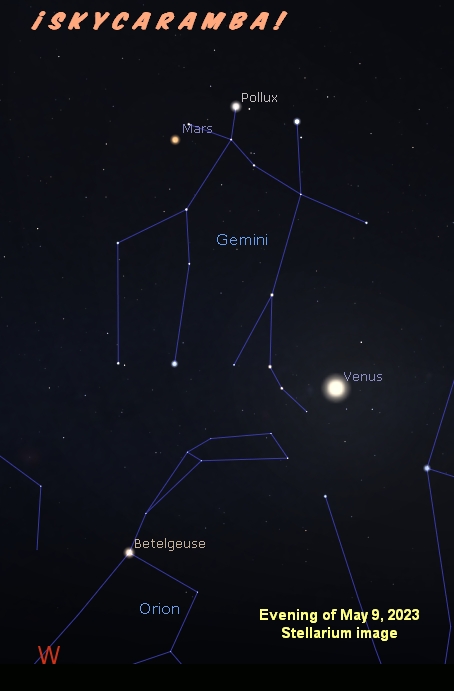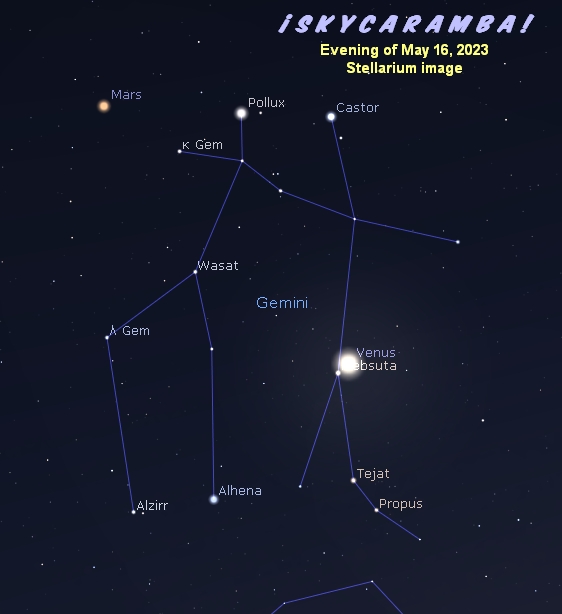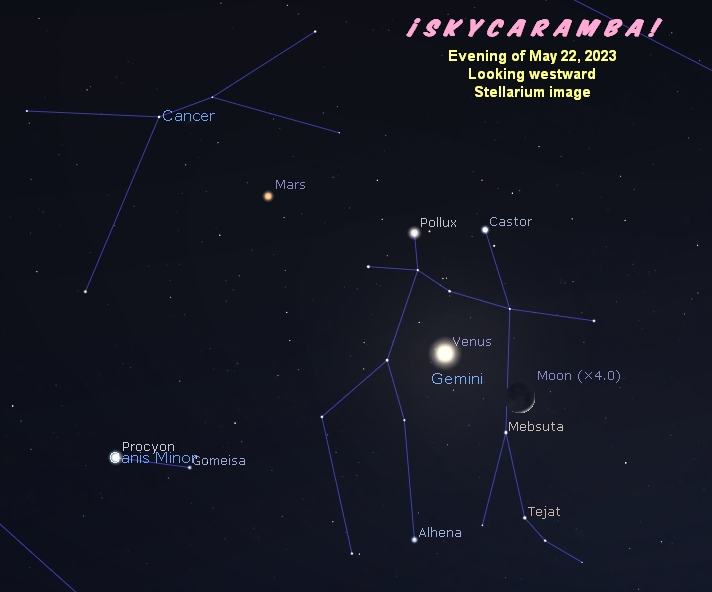
For northern hemisphere sky watchers, Orion is signaling that winter is long gone. The hunter sets in the early evening. Southern hemisphere observers can take this as a sign of winter. Venus is nearby. It’s close to the star El Nath at the edge of Taurus and Auriga when May starts. Mars starts the month close to Wasat in Gemini. A gibbous moon just past first quarter is south of Chertan in Leo. Saturn is fairly easy to see before sunrise in Aquarius. Jupiter is emerging from solar conjunction into the morning sky. The best views at the start of the month are from about 25° south. Mercury is almost at inferior conjunction, so you won’t see it when May starts.

Venus approaches Gemini over the next nine evenings or so. It’s entering the constellation as Mars leaves it. The red planet passed close to Mebsuta last month. This month, it’s Venus’s turn. Mars passed very close on the south side of the star in April. Venus will be a little farther as it goes by the north side of the star. This month’s Venus-moon pairing is in the evening right in the heart of Gemini. See them on the 23rd and 24th. The moon is by Mars on the 25th.

Venus has a close call with Kappa Geminorum on the 30th. As the end of May approaches, it becomes obvious that Mars is marching right into the beehive in Cancer. What a wonderful sight that’s going to be around June 4th and 5th.

See an almost full moon near Spica on May 4th. The moon’s just past last quarter when it passes by Saturn on the morning of the 13th. A very thin crescent moon is near Jupiter on the morning of the 17th. The best views of the big planet continue to be from around 25° south. Mercury is below them by this time of the month. While the two planets are rising earlier each morning until around the 22nd, they’re both retrograde. That means they’re moving eastward compared to the stars behind them. So they appear to be dropping back toward the sun. Mercury actually does start heading sunward after the 22nd.

A few careful observers may see Uranus emerge into the morning in the last few days of the month. Again, southern hemisphere sky watchers get the best view.
The moon passes in front of Porrima on May 3. The view is from southern South America, the Falkland Islands, and South Georgia Island.

The moon passes through Earth’s outer shadow on the 5th. The penumbral eclipse lasts about four-and-a-quarter hours from 15:14 UT to 19:32. It will be a moonset event for the western Pacific and northeast Asia and a moonrise event for the southern Atlantic, most of Africa, most of Europe, and western Asia. All of the eclipse is visible for most of Asia, the Indian Ocean, Australia, and Antarctica. Penumbral eclipses are hard to see. The moon dims a little as the earth blocks some sunlight from reaching it directly. You may see a sort of gradient effect from the north side of the lunar disk to the south side with the moon being dimmer on the north side. Some color variation is possible too.
The moon’s almost at first quarter when it passes by Al Jabhah on the 27th.
